Oh yes, the 4th to 6th
Century austere churches with their magnificent mosaics are spectacular
and are one of the great treasures of the Western world.
But, Ravenna itself turned out to be an unexpected delight.
One of our dear friends, Leslie, loves Ravenna and has always
encouraged us to squeeze it in with the recommendation:
“When you tire of the Renaissance and need to flee it, go to
Ravenna for the simple, clean, quite Byzantine architecture.”
Well, we understood what she was saying, but we really never tired
of the Renaissance. Still, we did want to see the mosaics that reportedly
constituted the greatest Byzantine art collection in the world.
Ravenna, with its fine port, was important
to ancient Rome, and
later in the 4th Century it became the Western Empire’s main
outpost in Italy. The
magnificent artistic decorations so famous in Constantinople at the time
became commonplace in Ravenna. Later
in the 7th and 8th Century when the Iconoclasts
destroyed all the images in the East, the churches of Ravenna escaped
desecration and remarkably survive intact to this day.
We were excited to be finally seeing these treasures, but still, we
were a bit dismayed; neither Leslie nor our other friends who had preceded
us to Ravenna had told us what a delightful place it is to visit.
Ravenna appears to be a fairly
wealthy city. Beautifully
kept. Very clean with elegant shops and caffés in the centro,
although spared the designer boutiques of the more famous tourist centers
. A wonderful city for
walking, almost all of the important sites can be seen while strolling the
lovely and ancient center city. I
think two days is a minimum stay here – anything less will surely not
give you a feeling for the place, and seeing the major sites will become a
task, not the pleasure it should be.
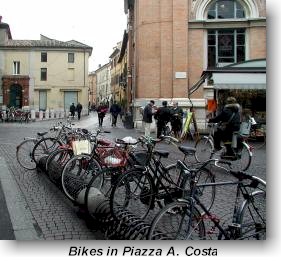 The
most lasting impressing we have of daily life in Ravenna is the
bicycles. Everywhere. Under
everyone. Young and old.
I guess because it is flat and compact, bicycles are particularly
well adapted to the city. The center city is very hostile to vehicles.
The extremely narrow streets wind between ancient buildings; many
are completely off-limits to vehicles or are one-way and seem to go
nowhere. And of course,
parking is maniacally difficult and expensive. How fortunate for Ravenna that the insidious mopeds of
Rome and Florence don’t flourish here.
It seems, too, that there is an organized city-sponsored
The
most lasting impressing we have of daily life in Ravenna is the
bicycles. Everywhere. Under
everyone. Young and old.
I guess because it is flat and compact, bicycles are particularly
well adapted to the city. The center city is very hostile to vehicles.
The extremely narrow streets wind between ancient buildings; many
are completely off-limits to vehicles or are one-way and seem to go
nowhere. And of course,
parking is maniacally difficult and expensive. How fortunate for Ravenna that the insidious mopeds of
Rome and Florence don’t flourish here.
It seems, too, that there is an organized city-sponsored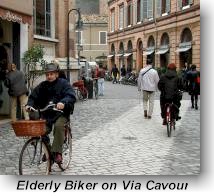 use of bikes. We noticed
municipal racks all over town that had two built-in key locks.
People just
take any one on the rack and go where they need, leaving it on another
city rack. We learned
later from a resident that the bikes are in fact city owned and are free
for residents and tourists alike!
We were impressed
to see lots of elderly folks peddling about their chores with their
baskets filled with groceries and the like.
The Green Movement needs to send representatives to Ravenna to
learn a lesson, for it gives this city a wonderful atmosphere and
serenity.
use of bikes. We noticed
municipal racks all over town that had two built-in key locks.
People just
take any one on the rack and go where they need, leaving it on another
city rack. We learned
later from a resident that the bikes are in fact city owned and are free
for residents and tourists alike!
We were impressed
to see lots of elderly folks peddling about their chores with their
baskets filled with groceries and the like.
The Green Movement needs to send representatives to Ravenna to
learn a lesson, for it gives this city a wonderful atmosphere and
serenity.
We arrived in Ravenna after driving
down from Venice, having spent the afternoon at Chioggia where we
had a wonderful lunch. It
started raining pretty hard as we left Chioggia so the drive through the
Po River delta on the Strada Romea (Rt 309) was more intense that I
like it on vacation. It is a fine road, passing through the lovely preserves of
the Grande Bonifica Ferrarese and the Valli di Comácchio,
but there are a good number of commercial vehicles as this is the only
North-South highway near the coast.
Rubber-necking the sights in the driving rain was not very
enjoyable. We passed right
next to The Abby at Pomposa, not something I had been aware of.
But my newest installment of Bell’Italia Magazine has it
on the cover, declaring it la regina della abbazi, the queen of the
abbys! Well. That’s what I love about Italy. There is always a reason to go back, and Ravenna has much to
go back to.
Albergo Cappello
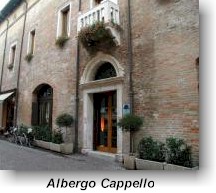 The
images of our arrival at the Albergo Cappello
remain intense. We pulled-up in front of the hotel on the very narrow street
where there is absolutely no parking.
I left Kris with the car and headed into the hotel. There I met the lovely and ever-effervescent proprietress
Francesca. Young and
beautiful, Francesca was alive with energy and ever-so eager to help.
She grabbed an umbrella and flew out to the car, grabbed our bags,
and with her slight frame dragged them into the hotel.
The parking garage was down at the end of the street, she said,
straight past the corner, on the dog-leg to the right. But, she cautioned,
the cross street was one-way --- the wrong way.
“Don’t worry. Just wait until no one is coming.
OK. Just follow me.” She ran to the end of the street umbrella overhead, in front
of the car, and held the traffic at bay while I negotiated the corner.
She assured me that had I followed the correct one-way, it would be
too complicated. and I would be hopelessly lost.
The
images of our arrival at the Albergo Cappello
remain intense. We pulled-up in front of the hotel on the very narrow street
where there is absolutely no parking.
I left Kris with the car and headed into the hotel. There I met the lovely and ever-effervescent proprietress
Francesca. Young and
beautiful, Francesca was alive with energy and ever-so eager to help.
She grabbed an umbrella and flew out to the car, grabbed our bags,
and with her slight frame dragged them into the hotel.
The parking garage was down at the end of the street, she said,
straight past the corner, on the dog-leg to the right. But, she cautioned,
the cross street was one-way --- the wrong way.
“Don’t worry. Just wait until no one is coming.
OK. Just follow me.” She ran to the end of the street umbrella overhead, in front
of the car, and held the traffic at bay while I negotiated the corner.
She assured me that had I followed the correct one-way, it would be
too complicated. and I would be hopelessly lost.
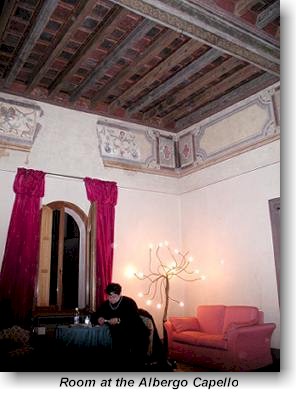 When I returned and took a breath I
was able to take in the hotel; I was stunned.
What a find! I had
read about this place in a very tiny article; it struck me as interesting.
So I had taken a gamble, as I could find no other references to
substantiate it. The ground
floor is taken up with a bar and quite a fancy restaurant not associated
with the hotel. The 7-room
hotel is one flight up on the piano nobile. The central large room, the traditional Venetia pòrtego,
serves as a grand foyer, lounge and administrative area.
Off the foyer are four large rooms, and there are three additional
rooms off an annex. We had
one of the four principal rooms of immense proportions.
Almost a cube, with the original painted beam ceiling’s height
matching the length and width. The beautiful original fresco frieze has been restored.
There are modern built-in closets, a dressing room, and a totally
luxurious all-marble bath.
When I returned and took a breath I
was able to take in the hotel; I was stunned.
What a find! I had
read about this place in a very tiny article; it struck me as interesting.
So I had taken a gamble, as I could find no other references to
substantiate it. The ground
floor is taken up with a bar and quite a fancy restaurant not associated
with the hotel. The 7-room
hotel is one flight up on the piano nobile. The central large room, the traditional Venetia pòrtego,
serves as a grand foyer, lounge and administrative area.
Off the foyer are four large rooms, and there are three additional
rooms off an annex. We had
one of the four principal rooms of immense proportions.
Almost a cube, with the original painted beam ceiling’s height
matching the length and width. The beautiful original fresco frieze has been restored.
There are modern built-in closets, a dressing room, and a totally
luxurious all-marble bath.
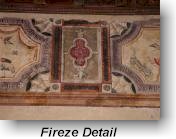 This building had been lovingly
restored with very expensive materials.
The polished stucco stone walls were colored in the most amazing
subtle hue, taken from the restored original fresco freezes surrounding
the ceilings. The floors are wood – very unusual in Italy, especially
this area, where terrazzo and other stones are almost exclusively used.
An unusual wood – very wide planked – and dyed the same subtle
tone – a warm green/blue – as the walls.
The modern stone stairway coming up to the piano nobile was of such
magnificent quality that you couldn’t help finger the carved banister.
The interior decoration is completely unified with eccentric modern
fixtures and built-in furniture. Very
modern. Very minimalist. Very Italian. So
what gives here, we thought? Something is not right. It is not possible that this kind of effort and expense went
into restoring a palazzo for such a modest hotel.
This building had been lovingly
restored with very expensive materials.
The polished stucco stone walls were colored in the most amazing
subtle hue, taken from the restored original fresco freezes surrounding
the ceilings. The floors are wood – very unusual in Italy, especially
this area, where terrazzo and other stones are almost exclusively used.
An unusual wood – very wide planked – and dyed the same subtle
tone – a warm green/blue – as the walls.
The modern stone stairway coming up to the piano nobile was of such
magnificent quality that you couldn’t help finger the carved banister.
The interior decoration is completely unified with eccentric modern
fixtures and built-in furniture. Very
modern. Very minimalist. Very Italian. So
what gives here, we thought? Something is not right. It is not possible that this kind of effort and expense went
into restoring a palazzo for such a modest hotel.
Francesca held the answer, and it is
a wonderful and mysterious story. The
building is a Venetian gothic palazzo, 14th C.
Its location is impeccable, on the tiny Piazza A. Costa
opposite the large indoor market at the end of Via Cavour, the main
shopping-passeggiata street.
You can’t get more central and convenient for a walking tour of
Ravenna. The building was in
the hands of a famous and very rich industrialist, whose chemical business
forms one of the economic backbones of the Ravenna area.
The industrialist went about restoring the building together with
an architect friend, Valerio Evangelisti.
It was to be their home. They
hired the amazingly famous Gae Aulenti to do the interior design.
So, nothing was spared. Everything
was lavished on the creation. The top floor, an attic under the eves (now a small
conference center) was designed as a studio.
The new roof was constructed in the inverted ship keel fashion, so
that the ribs would be visible from beneath – with no pillars to
support. Evangelisti designed
this because the industrialist was an avid boatman.
(This room is beautiful). The
wood floor we had admired is an exotic soft wood from Canada that was
milled specially for Aulenti and dyed and treated with an experimental
solution from the industrialist’s laboratory.
And so much more.
Then a tragedy.
The industrialist committed suicide.
No one knows why. It
threw the entire Ravenna area into economic chaos for several years, and
the totally completed building into limbo for seven years.
Just sitting there empty. It
was then that Francesca made a proposition to a small local hotel chain to
operate the building as a hotel and conference center, using much of the
chain’s infrastructure. Voila!
There it is. This beautiful, energetic lady tending a drop-dead gorgeous
hotel, in the perfect location ------ with a rack rate of $95!
I just couldn’t believe that I was staying in a place designed by
Gae Aulenti, the same woman who designed the highly famous Musée d' Orsay in Paris and is now doing our own San Francisco Museum of
Oriental Art. Much of the
intrigue remains. I am sure I
got the story jumbled from Francesca who’s English is not perfect.
What was the relationship between the industrialist and Evangesisti?
Why did he commit suicide? To
add to the atmosphere, while we stayed at Albergo Cappello, the news was
brimming with the story that the son of Italy’s most famous and richest
industrialist, Giovanni Agnelli, had committed suicide.
The cycle continued when we arrived at our next hotel in Urbino,
there was a framed letter on the wall from Signora Agnelli thanking them
for a warm and comfortable stay in the mini-suite we occupied. We could only think of her grief at the loss of her only son,
and the suicide of an industrialist in Ravenna whose name we did not even
know.
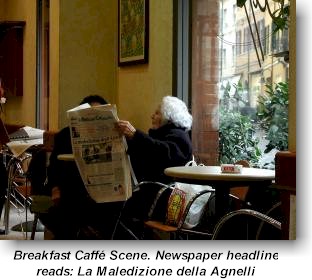 The Cappella makes arrangements with
a café across the street to serve you breakfast, included in your room
rate. It was a blessing,
because we got up and out early, not tempted to lounge around in the
luxury of our room. Breakfast
was lovely, and we enjoyed watching the locals come by for their morning
coffee, reading the paper, and sharing some gossip.
The evening before, we had traipsed through the rain to a
Francesca-recommended restaurant, the Bistro.
It was a lovely dinner in a modern restaurant tucked into an
ancient building and filled with beautiful people.
While the meal was excellent, it didn’t match our desires.
It was international cuisine with a very French flair.
When traveling, we almost always prefer to eat local cuisine so
that we can immerse ourselves in the culture.
The Cappella makes arrangements with
a café across the street to serve you breakfast, included in your room
rate. It was a blessing,
because we got up and out early, not tempted to lounge around in the
luxury of our room. Breakfast
was lovely, and we enjoyed watching the locals come by for their morning
coffee, reading the paper, and sharing some gossip.
The evening before, we had traipsed through the rain to a
Francesca-recommended restaurant, the Bistro.
It was a lovely dinner in a modern restaurant tucked into an
ancient building and filled with beautiful people.
While the meal was excellent, it didn’t match our desires.
It was international cuisine with a very French flair.
When traveling, we almost always prefer to eat local cuisine so
that we can immerse ourselves in the culture.
There seems to be a very strong economic connection between Ravenna
and France. There are a lot
of French people about. I am
interested in understanding the historic roots of this.
The wet evening stroll served a good purpose, however.
It oriented us to the major monuments and the shopping street, so
in the morning we knew just where we were heading, and it was what should
be the first stop on
any trip to Ravenna, San Vitale.